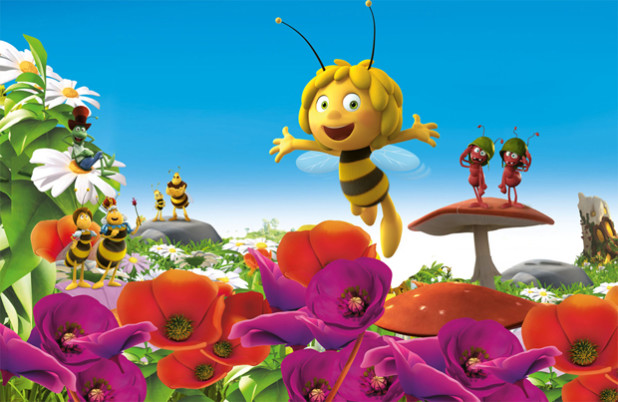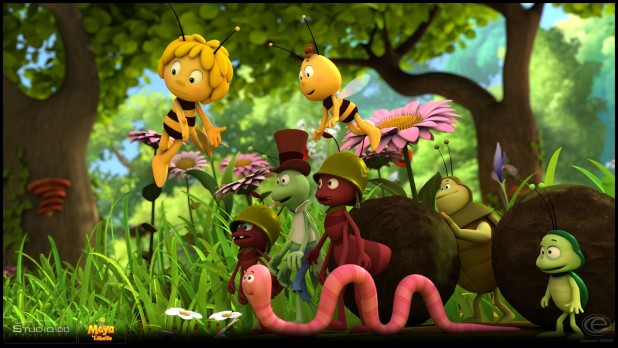Morgoth’s Review
August 14, 2016
I recently watched a CGI cartoon movie called ‘Maya the Bee’, I find it fascinating to observe the means by which destructive ideas are pumped into the minds of small children and Maya the Bee didn’t disappoint. After watching the movie I did the inevitable Google search to see who was behind it and discovered, with no surprise whatsoever, that Maya the Bee’s production company was the creation of a ‘Holocaust Survivor’ Jew, and the Australian government’s ‘Screen Australia’.
But that’s not where the story ends, Maya was not the creation of a Jew or a liberal left SJW, Maya’s creator was German Nationalist, Waldemar Bonsels, Bonsels described Jews as “a deadly enemy” who were “poisoning the culture”. The original Maya the Bee written by Bonsels was published in Germany in 1912, Bonsels then went on to support National Socialism in Germany and penned articles for the NSDAP. Waldemar Bonsels has flawless Nationalist credentials, his Maya is a Nationalist fable for young German girls, the 2014 movie is also fable for young girls, but of a very, very different sort.
SJW Maya
Maya the Liberal
Maya the Bee, the movie, opens with Maya hatching from a honeycomb inside the beehive. We learn at once that Maya is a willful and independently minded young bee with scant regard for conformity and adherence to the social order of the well run and organized hive. Maya questions her teachers when they explain the dangers of the meadow and the bee’s arch rivals, the hornets. The queen bee of the hive (voiced by Jewish character actress Miriam Margolyes) indulges the spirited Maya, however, ”Buzzlina Von Beena”, a quasi-fascist who’s plotting against the queen, becomes angered and eventually expels Maya.
The scene is now set for Maya to enter the larger insect society of the meadow which surrounds the hive. Remarkably, everything the teachers taught Maya on the dangers of the meadow turn out to be false, the other insects pose no threat to Maya whatsoever, indeed, the action is largely predicated on Maya helping the other insects. In one scene Maya is greeted by a grasshopper who offers dragonfly rides and all singing all dancing concerts akin to an insect version of Woodstock. Meanwhile, back in the hive, Buzzlina has succeeded in her coup against the queen and is now plotting to wage war on the hornets, using them as a scapegoat.
During her adventures in the meadow Maya becomes friends with a young hornet boy called Sting, because neither Maya nor Sting are aware of the species of ‘The Other’ they don’t see each other as enemies, racism and suspicion of the other is a learned trait, you see, passed on by society and parents etc. Maya and Sting eventually learn each other’s real species and what’s more, they discover that bees and hornets are on the verge of war!.
Rushing back to the hive the two youngsters free the queen and head to where the battle is about to begin where they can bring peace and thwart the fascist Buzzlina’s plot. Viewing the battle Maya learns that a scarecrow is about to fall on the scene, killing all of the various insects assembled, ants, beetles, bees, flies, hornets and butterflies. Maya explains that if they all work together, using all of their ‘diverse’ strengths and specialties, disaster can be averted.
And so peace and harmony finally returns to the meadow, and not just that, Maya and the queen declare that the borders surrounding the hive, and even its doors! be thrown wide open to every insect in the meadow and the precious honey stored by the bees will be freely available to all, even the stinking dung beetle, loathed by everyone, will have his diversity celebrated. Maya begins a new career as a goodwill ambassador to insects entering the meadow and presumably the hive. (This really is what happens!)
We will never know what Waldemar Bonsels would make of this travesty, but we do at least have his original book which can be read in full here. Bonsels’s Maya the Bee is a beautifully written parable and at some point I’d like to dedicate a whole post to exploring it, for now, we can contrast its ideals and morality to the dire multicult propaganda of the 2014 movie, which appeared just one year before Germany was swamped with 1.5 Million hornets Muslims.
Nazi Maya
Maya The Nationalist
The Bonsels’s 1912 book opens with Maya hatching in a tumultuous hive with bees seeking to break away and form their own hive. Maya is inquisitive rather than rebellious, innocent rather than cynical. She is set to leave the hive with an older bee to explore the meadow and leaves with these parting words of wisdom from her teacher:
“The first rule that a young bee must learn,” said Cassandra, and sighed, “is that every bee, in whatever it thinks and does, must be like the other bees and must always have the good of all in mind. In our order of society, which we have held to be the right one from time immemorial and which couldn’t have been better preserved than it has been, this rule is the one fundamental basis for the well-being of the state
And:
“Be polite and agreeable to every insect you meet,” she said in conclusion, “then you will learn more from them than I have told you to-day. But beware of the wasps and hornets. The hornets are our most formidable enemy, and the wickedest, and the wasps are a useless tribe of thieves, without home or religion. We are a stronger, more powerful nation, while they steal and murder wherever they can”.
Shortly after flying out of the hive a strong gust of wind separates Maya from her instructor, and so like before, Maya is now out in the wider world alone, but this will be a very different meadow and Maya will be having a very, very different adventure.
The charming little Maya buzzes around the meadow meeting various insects, not all of whom are unfriendly or dangerous toward Maya, but they are different, they have their own natures and offer Maya not much more than passing curiosity. Maya becomes friends with a bluebottle called Jack Christopher, however the friendship is short lived as Bonsels’s dragonflies are not offering free roller-coaster rides as the 2014 incarnations do:
“Why, what’s the matter, child?” The dragon-fly’s tone, surprisingly, was quite friendly.“Let him go,” cried Maya, and tears came into her eyes. “His name is Jack Christopher.”The dragon-fly smiled.“Why, little one?” it said, putting on an interested air, though most condescending.Maya stammered helplessly:“Oh, he’s such a nice, elegant gentleman, and he’s never done you any harm so far as I know.”The dragon-fly regarded Jack Christopher contemplatively.“Yes, he is a dear little fellow,” it replied tenderly and—bit Jack’s head off.
Bonsels’s meadow is a brutal and unforgiving place, Maya is forced to learn through her experiences that her individualism and non-conformity come with an extraordinarily high price, a price she pays again and again throughout the story. Maya’s freedom amounts to shivering alone, scared and hungry inside a flower while yearning for the sanctuary of home:
”Oh, thought Maya, how happy it made you to be able to count yourself one in a community like that, to feel that everybody respected you, and you had the powerful protection of the state. Here, out in the world, lonely and exposed, she ran great risks of her life. She was cold, too. And supposing the rain were to keep up! What would she do, how could she find something to eat? There was scarcely any honey-juice in the canterbury bell, and the pollen would soon give out.”
Bonsels is genuinely trying to terrify young German girls into loyalty and obedience, not for the sake of power, as Marxists would have it, but for their own good, their safety. It is understood by the other insects that the bees are a powerful force, and that Maya, belonging to that force, deserves to be treat with respect. Unlike the bluebottle who can be decapitated without consequence.
One of the most grueling passages, however, is Maya’s encounter with a spider and its web:
The tears streamed from Maya’s eyes; she lost her last shred of self-control. She tossed her captive body to and fro, and buzzed as loud as she could, and screamed for help—from whom she did not know. But the more she tossed the tighter she enmeshed herself in the web. Now, in her great agony, Cassandra’s warnings went through her mind:
“Beware of the spider and its web. If we bees fall into the spider’s power we suffer the most gruesome death. The spider is heartless and tricky, and once it has a person in its toils, it never lets him go.”
In a great flare of mortal terror Maya made one huge desperate effort. Somewhere one of the long, heavier suspension threads snapped. Maya felt it break, yet at the same time she sensed the awful doom of the cobweb. This was, that the more one struggled in it, the more effectively and dangerously it worked. She gave up, in complete exhaustion.
“Please kill me right away.”
“Really!” said the spider, tying a few torn threads together. “Really! Do you take me to be as big a dunce as yourself? You’re going to die anyhow, if you’re kept hanging long enough, and that’s the time for me to suck the blood out of you—when you can’t sting. Too bad, though, that you can’t see how dreadfully you’ve damaged my lovely web. Then you’d realize that you deserve to die.”
In the 2014 happy-clappy multicult version there is no cruel spider because the message they’re sending out to young girls is that there are no dangers or predators in the world, indeed, the SJW Maya would probably be lobbying the queen to make arachnophobia a Hate Crime.
Maya finally begins to see the folly of her idealistic, carefree existence after being captured by the hornets. Bonsels’s description of the hornets ‘fortress’ is reminiscent of the darker passages of Tolkien:
By the one thread of light she managed bit by bit to make out her surroundings. Horror of horrors! Maya was almost congealed with fright: the floor was strewn with the bodies of dead insects. At her very feet lay a little rose-beetle turned over on its back; to one side was the skeleton of a large locust broken in two, and everywhere were the remains of slaughtered bees, their wings and legs and sheaths.“Oh, oh, to think this had to happen to me,” whimpered little Maya. She did not dare to stir the fraction of an inch and pressed herself shivering into the farthest corner of this chamber of horrors.
Maya discovers that the queen hornet is about send her legions to Maya’s hive to slaughter her fellow bees, loot the hive and then destroy it:
“My country!” she sobbed, “my bees, my dear, dear bees!” She pressed her hands to her mouth to keep herself from screaming. She was in the depths of despair. “Oh, would that I had died before I heard this. No one will warn my people. They will be attacked in their sleep and massacred. O God, perform a miracle, help me, help me and my people. Our need is great!”
“If my people are to be vanquished and killed, I want to be killed, too. But first I must do everything in my power to save them.”
“Long live my queen!” she cried.
Bonsels deploys a clever plot device to make the case for racial solidarity. Maya manages to approach a young hornet sentinel and discovers he’s rather smitten by the dragonfly who beheaded Jack Christopher, Maya then explains that she knows where the dragonfly lives and that if he frees Maya she’ll explain where. And thus Maya is released from the hornet’s fortress and flies home to warn the queen, and the powerful hornets have been compromised by a race traitor, which they subsequently recognize:
“It is true, we are a more powerful race, but the bees are a unified nation, and unflinchingly loyal to their people and their state. That is a great source of strength; it makes them irresistible. Not one of them would turn traitor; each without thought of self serves the weal of all.”
And so Maya learned the error of ways and saved her people and nation and is duly rewarded by the queen:
“You did not forget your home and your people,” she said kindly. “In your heart you were loyal. So we will be loyal to you.
Henceforth you shall stay by my side and help me conduct the affairs of state. In that way, I think, your experiences, all the things you have learned, will be made to serve the greatest good of your people and your country.”
To Bee or not to Bee
The most infuriating aspect of the modern liberal version of Bonsels’s fable is that Bonsels had already debunked their thinking in his original, he had preempted the argument and destroyed it. 1912 Maya begins life with a certain set of ideals, childish ideals, through experiences and hardship she evolves and changes how she views the world, she has a character arc. It speaks volumes that the modern version of the fable has Maya born with a set of beliefs and then the world and all reality is warped so that those beliefs can be confirmed, that she can be proven correct.
In Germany today there will literally be young women and girls called Maya, they will still be supporting a hornet Muslim invasion of the German hive despite the violence, rapes and brutality they have brought. What we’re all waiting for is for the real life Mayas to begin their own character arc, to allow their own preconceived ideas to be challenged, and, like Bonsels’s Maya, to see the error of their ways.




